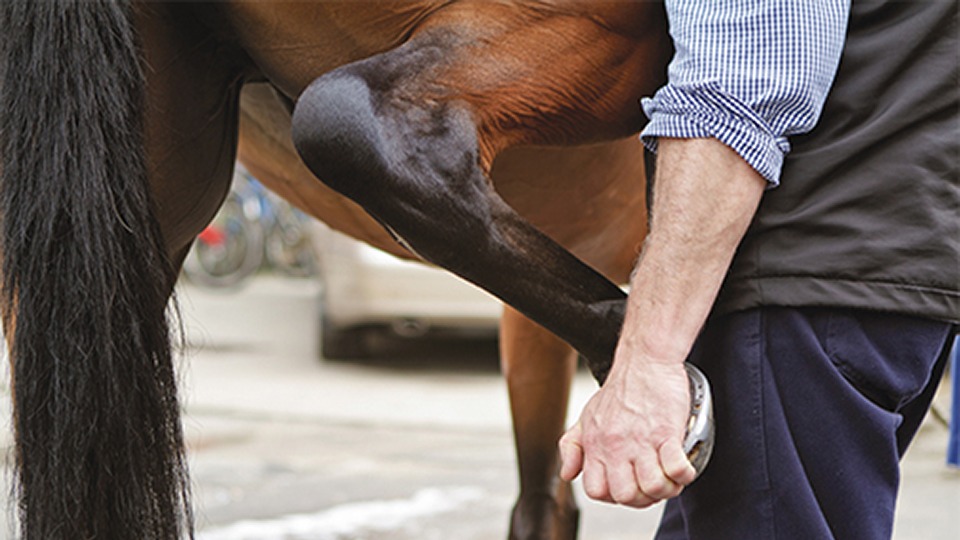Proper joint care can do wonders for your horse’s soundness
Multiple studies indicate that joint injuries are prevalent not only among Standardbred racehorses, but also across the board in many other equine disciplines. Jennifer Selvig, DVM, equine medical director at Cleary Lake Veterinary Hospital, in Prior Lake, Minn., provides an informed perspective into the care, prevention and treatment of equine joint injuries.
Prevention is Key
According to Dr. Selvig, ensuring that the horse is appropriately trained and conditioned for the task it will be asked to perform, managing any conformational or health challenges the horse may face, and paying careful attention to the horse’s diet are all key preventative measures to ensure good joint health to the extent possible.
“The musculoskeletal system in horses is very good at compensation,” Dr. Selvig says. “So, if you haven’t done the proper training for whatever discipline the horse is supposed to be doing, the muscles won’t be strong enough and the joints will be forced to take the brunt of the excess load.”
She explains that proper conditioning for the horse’s intended sport is the top factor in terms of joint care. However, concerning joint health, there are now many other things that can be added to the horse owner’s or trainer’s preventative medicine toolkit.
“There are various supplements that have some good research behind them,” she says. “There are also drugs and other medical devices that can be helpful.”
Her list includes Adequan, Legend, Pentosan and Polyglycan as examples of injections that can be administered to performance horses on a precautionary basis. While these injections are optional and are not considered cornerstones of equine joint care, they can be beneficial and work to augment such key areas as conditioning and nutrition.
Each horse’s conformation also plays a role in preventative care.
“If, for example, you have a horse that is very toed in, it is going to be more prone to developing osteoarthritis in the fetlock,” Dr. Selvig says. “You have to take that into account.”
Preventatively speaking, while you can’t change the direction that a leg is pointing, you can work with your veterinarian and farrier as a team to take and evaluate frequent X-rays that can provide you with valuable insight about the balance of the hoof that isn’t always possible to see from the outside.
Good hoof care is also paramount.
“Everything starts from the ground up,” says Dr. Selvig. “If you have poor hoof balance, angles or quality, all of those things are going to translate to more stress on other structures in the leg.”
Finally, chiropractic care and massage therapy can also play small yet helpful roles in preventative joint maintenance.

An Impactful Injury
Joint injuries, regardless of their origin, can and do impact athletic careers.
“I think what people think of most with joint injuries and joint care is lameness,” Dr. Selvig says, noting that since lame horses are unable to perform, lameness is often the primary reason for a veterinary referral. While there are other reasons outside of a joint injury that a horse may be lame, this symptom is usually the chief complaint.
When evaluating lameness, Dr. Selvig uses a modified version of the lameness scale developed by the American Association of Equine Practitioners (AAEP). She says that any lameness greater than a Grade 1 will limit performance. In many cases, she says, the recommendation is not to work a horse that is clinically lame. Beyond that are performance issues, which often don’t result in a lameness but may manifest as something more subtle.
“These things may still be related to joint problems, even though they are not manifesting as a lameness,” says Dr. Selvig.
A Prevalent Condition
Multiple studies indicate that joint injuries are common among performance horses of all types. Dr. Selvig advises clients that hard-working, athletic horses, especially those in the middle or late stages of their careers, are likely to need some type of joint help. As for those horses participating in disciplines where speed is a factor, she says that knee and fetlock injuries are common. Standardbred racehorses, she says, can also be afflicted with hind limb, neck and shoulder issues more commonly seen in horses being driven in harness.
Diagnosis
Along with the previously mentioned lameness, a change in performance — even something as slight as being a few fifths of a second off their normal time during a race — can be an indicator of a joint injury. Dr. Selvig says that this kind of sign may indicate osteoarthritis or the development of inflammation of a joint over time. In the case of an injury, she says you may see heat or swelling that is related to a chip fracture, an acute sprain or synovitis (an inflammation of the joint capsule).
“There can be associated soft tissue structures as well,” Dr. Selvig says. “One common one that we see is injury to the collateral ligaments of the coffin joint. The injuries can be joint adjacent.”
Definitively diagnosing a joint injury, regardless of the type, typically involves a physical exam, flexion tests, X-rays, and, in some cases, ultrasound.
AAEP Lameness Scale
The American Association of Equine Practitioners (AAEP) has developed a five-point grading system for veterinarians to use when assessing for lameness. Dr. Selvig uses a modified version of the scale outlined below.
0: Sound.
1: Inconsistently lame.
2: Consistently lame at the trot under certain conditions.
3: Consistently lame at the trot.
4: Consistently lame at the walk.
5: Non-weight-bearing on the affected limb.
Treatment Protocols
The specific treatment protocol for a joint injury depends on its location and severity.
“If you have an acute injury, such as a racehorse with a chip fracture, the treatment is going to be surgical removal and cleanup of the cartilage arthroscopically,” Dr. Selvig says. “That’s going to be the gold standard.”
She adds that, depending on the location of the fracture, it can be detrimental in the long run to simply give the horse time off and not remove the fragment. Over time, the unremoved fragment can lead to the development of significant osteoarthritis — a common outcome that can impact the horse’s long-term soundness.
As for chronic joint issues, she says there are multiple treatment options.
“I think most people are familiar with the concept of joint injections with steroids, or ‘cortisone,’” Dr. Selvig says.
Although some current studies indicate that injecting hyaluronic acid into joints may not be as useful as it was once perceived to be, it is not harmful and is still a part of many treatment arsenals.
The use of orthobiologic products is also among recommended treatment protocols.
One such product, IRAP, produces autologous conditioned serum which contains active quantities of anti-inflammatory and regenerative cytokines. Another product, Pro-Stride APS, highly concentrates three components of blood plasma, platelets, and white blood cells. Both products are processed from a horse’s own blood.
“Through the processing, usually involving some sort of filtration centrifugation system, we are essentially amplifying some of the natural anti-inflammatory and growth factors already present in the horse’s blood,” explains Dr. Selvig, adding that the process uses the horse’s own immune system to mitigate the inflammation in the joint. “We process the horse’s blood and inject it right back into the problem area.”
Dr. Selvig says that there is also a line of polyacrylamide gels.
“These are not an anti-inflammatory product,” she says. “They are more of a cushioning product. These products are injected directly into the joint, and they provide a physical barrier of sorts that acts as a cushion for the joint inside.”
Use Caution
Whether racing or competing in other disciplines, Standardbreds, like other breeds, are subject to strict time limitations put in place by the governing bodies of many performance horse sports regarding the use of various joint treatment options. While none of the treatment options are fully illegal, Dr. Selvig says that there are withdrawal times involved, and she advises checking with the organization involved well in advance of the anticipated competition date to see what those restrictions might be.
Though not involving the use of medication, Dr. Selvig cautions that even treatments such as shockwave therapy can have rules regarding withdrawal times, so it is important to keep abreast of any rule changes or additions you may not be aware of.
Final Advice
One treatment area that Dr. Selvig says deserves special consideration is the use of oral joint supplements.
“There are a few decent ones,” she says. As for others, she says they may not have good studies behind them. The problem, she explains, is that there is not a lot of regulation for joint supplements.
“We really don’t have any way of confirming that what the label says is actually in the product,” she explains, advising that supplements won’t substitute for anything, and they won’t make a lame horse sound.
Lastly, Dr. Selvig emphasizes never skipping the basics.
“Horses are athletes and they need to be treated like athletes,” she says. “You can’t medicate your way out of a horse that isn’t in proper condition or isn’t getting good nutrition and hoof care. You have to put in the work and, whether for prevention or treatment, invest the time.”
This story appears in the October 2025 issue of Hoof Beats, the official magazine of the USTA. To learn more, or to become a subscriber to harness racing’s premier monthly publication, click here.
